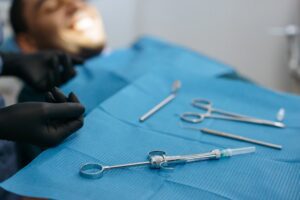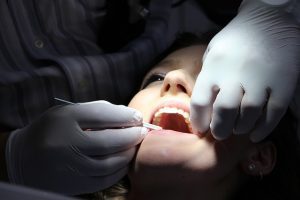Hearing the words “bone graft” can bring up fears of major problems and major surgeries. But in oral surgery, dental bone grafts are actually a small, simple, minimally-invasive tool that offers patients with jaw problems a solution to healing bone health.
In oral medicine, dental bone grafting is most often used in the context of dental implants. If your jawbone isn’t strong enough to properly heal around a dental implant on its own, a jaw bone graft can get you ready for dental implant surgery.
Another common application of dental bone grafting is during a wisdom teeth extraction, or other type of tooth extraction that doesn’t result in immediate reconstruction. Augmenting the bone with a graft is often used to shore up the bone and structure of the back molars.
So, how does dental bone grafting work? And why it is sometimes necessary for a variety of oral surgery procedures?
What is Jaw Bone Grafting?
A dental bone graft is a little scaffold made of live bone tissue from recycled teeth, known as dentin grafting. When paired with PRF, a platelet-rich concentration of the patient’s own blood materials, this tiny bone scaffold is meant to help your native bone heal weak spots.
This procedure is performed most often to prepare a patient for prosthetic teeth. Over time, bone volume at the site of missing teeth will diminish. Frequently, this results in a lack of adequate bone for dental implant surgery. Dental bone grafts are applied to the weak area in the jaw, where they encourage the jaw to generate new, healthy bone tissue.
Grafts augment the jaw bone naturally, improving the structure of the jaw over time. For dental implant surgery, patients need sufficient bone health in order to place implants in the best position for aesthetics and function. This optimizes the chances of the jaw integrating the implant successfully.
Types of Dental Grafting in Oral Surgery
Dr. Puckett utilizes a number of dental bone grafting techniques based upon the needs of your case. Grafting options and specific details are discussed during the consultation appointment. Grafting procedures routinely performed include:
- Socket preservation– addition of bone to an extraction site to preserve bone volume. Addition of grafting material to an extraction site will reduce the rate of natural bone shrinkage once a tooth is removed. This procedure will help prepare the site for an implant.
- Sinus grafting– addition of bone adjacent to the sinus to regenerate bone for implant placement. At times, with the removal of upper molars, additional bone height is needed to plan for an implant. Dr. Puckett has been utilizing a minor bone grafting technique for many years to increase the bone height through the extraction site – osteotome sinus grafting.
Performing the graft at the time of tooth removal routinely prevents to need for additional grafting when the implant is placed. This saves our patients additional discomfort and minimizes cost. At times we need to regenerate a significant amount of bone for implant placement at upper posterior teeth sites.
- Ridge augmentation– addition of bone in an area of the jaws when bone volume has diminished. Bone loss can occur in both horizontal and vertical dimensions. At the time of evaluation, Dr. Puckett will perform an oral examination, obtain a 3D CT scan, and combine all of the information to determine the sites and extent of bone volume loss. At that time, an appropriate plan can be formulated to restore your teeth and mouth function.
Dental Bone Grafting As it Applies to Wisdom Teeth Removal
A wisdom teeth bone graft is uncommon but sometimes necessary. Most of our patients will not need it when having their wisdom teeth removed. If it should be necessary, understand that a wisdom teeth bone graft is a simple and painless procedure that’s not nearly as scary as it sounds.
When a tooth is lost or extracted, there’s nothing stimulating the socket anymore, and the bone begins to deteriorate. This is why we advocate ASAP tooth replacement for missing teeth. However, wisdom teeth are the one form of tooth extraction for which we don’t suggest tooth replacement, so we have to use other means to preserve the jaw.
This is why sometimes a wisdom teeth bone graft is necessary after third molar extraction in order to support the jawbone of surrounding molars. This is particularly true if an impacted wisdom tooth grows horizontally and causes nearby teeth to have substantial bone erosion. You may form a cyst in the third molar area that can degrade much of the jawbone.
In either of these situations, we’d recommend adding a bone graft to the site of your wisdom teeth extraction. The good news is it’s a quick and painless procedure that has a quick recovery time. And it gives you reassurance that your mouth will be just as healthy as it was before, and that it’ll stay that way.
Is it Safe to Get a Jaw Bone Graft?
A minimally-invasive procedure that helps your body heal naturally, dental grafts are considered an extremely safe procedure. Often, the patient’s own material can be used for the graft, which means the body won’t reject it.
Common and expected symptoms from a bone graft – and any oral surgery – are a bit of swelling and pain/discomfort. For the vast majority of our patients, ice packs and OTC pain meds take care of it. We’ll also likely give you a round of antibiotics for the first week to protect the site from infection until it’s gotten the healing process going.
As an alternative to painkillers, we also offer an oral surgery recovery kit that uses homeopathic ingredients to reduce discomfort and swelling, speed healing and prevent infection. A 10-day regiment of rinses and topicals, many patients have reported no need for pain medication when using this holistic oral surgery recovery kit.
All these things make grafting the jaw an overall safe procedure with a minimal list of complications:
- Blood clots
- Complications with the anesthesia for oral surgery
- Graft rejection (in cases of allografts)
- Nerve damage
Keep in mind these complications are uncommon. At our practice, we’ve seen amazing things happen with jaw grafting, and we often use it to make previously-ineligible patients eligible for dental implant surgery.
Patient-Focused, Holistic Care Before, During & After Your Bone Graft
At Wilmington Oral Surgery, we operate under a patient-centered theory focused on optimizing quality of care in tandem with patient comfort. That includes sedation options for oral surgery to be used along with anesthetics, using the latest dental surgery tech to maximize success, taking a holistic approach to oral surgery, and working to make procedures like dental implant installation and wisdom tooth removal affordable.
Dr. Puckett always prepares patients to understand exactly what their treatment plan entails, and works with you to get you the best care possible. Your procedure will be precise, pain-free and calm. And after, we’ll advise you on the best post-op steps to take for better, faster healing.









